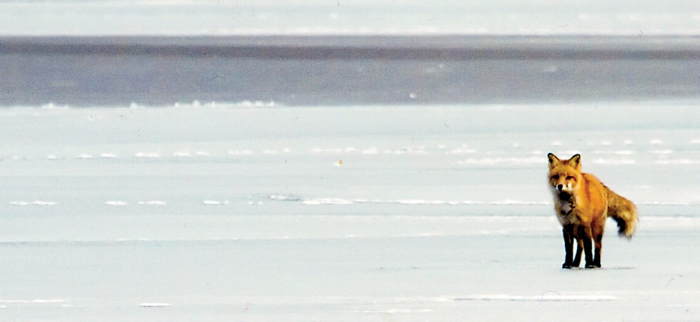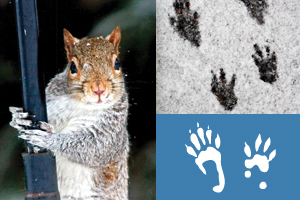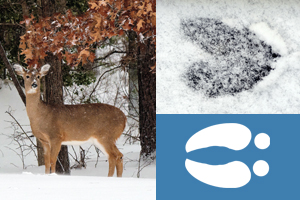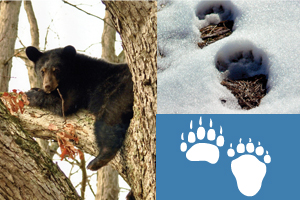Animal Treks: Identifying tracks in the snow

Fox in the snow; photo by Matthew Paushter
When visitors think of Maryland, they tend to picture a small state split by the Chesapeake Bay with mountains to the left and flat marshes to the right. They may also imagine a densely-populated state smack dab in the middle of the great Northeast Corridor, home to the urbanized belt running between Baltimore and Washington, D.C.—not necessarily an environment favorable to the wanderings of wildlife. But if you venture out on a cold winter’s day and set out on a course just beyond the back fences of suburban backyards, you are likely to find evidence of some of the state’s quieter residents without much effort at all, especially if the ground is covered in snow.
While home to 6 million people, wild animals of many shapes and sizes live among us, right under our noses. So you don’t have to go far to find animals in action. And I’m betting you’re just a little curious to know who and what has been on the move in your neighborhood while you weren’t looking. From tiny mice, moles and voles all the way up to deer and bears, Maryland’s native animal species each leave telltale signs behind.

Squirrel photo by Christine Boltz; tracks photo courtesy of Virginia State Parks
Getting started
Let’s start with some basic tracking principles.
A print is a single foot while a track more commonly refers to a series of prints that reveal the animal’s size and gait. Perfect prints are rarely found and they can be deceptively tricky, especially when there is deep or melting snow involved. With this in mind, look at the nature of the impression: Are there claw marks? How about pads and toes, and how many of each? What is the distance between prints?
Next, step back and assess your surroundings: What types of habitats are nearby? Is the animal headed toward a wood line or a waterway? Is the terrain rutted with burrows or ditches? What species are you pretty certain live in your area?
Working outward from your own front door, start with your domestic animal pet types: dogs and cats. If you’re a pet owner, the first tracks you spot are likely theirs. Both feature four toes and prominent heel pads. While easy to confuse, the most obvious distinguishing feature is that cats do not show claw imprints while dogs and foxes usually do show toenail marks.
In fact, felines are among the only mammals that do not leave claw marks, as they always retract their claws while walking. Domestic cats can be found everywhere, even in places surprisingly far from people. They also tend to direct register, meaning their hind feet land in the front tracks when moving in snow, helping them conserve energy. Domesticated dogs do not register and their tracks often wander irregularly as they pick up random scents. A dog’s triangular heel pads tend to be fairly small (about the size of three of their toes) while cat’s heel pads tend to be larger (about the size of four toes).

Deer photo by Lori R. Bramble; tracks photo courtesy of Virginia State Parks
Compact critters
You may find prints featuring a different number of toes on front and back paws. Small prints usually belong to squirrels and chipmunks, while very small prints are almost always mice or voles. Slightly larger but similar prints belong to groundhogs.
Rabbits and squirrels make a clump of four tracks in the snow, a space, then another clump of tracks. The large tracks are the hind feet, the small are the front. They are two of the most commonly seen after snowfall and feature one foot slightly ahead of the other. Rabbits have small, round toes and fur-covered feet, whereas squirrels have long fingers. In squirrel tracks, you may see the individual toes and they often end at the base of a tree. Both of these animals are hoppers, and the front feet go down and the larger hind hop over the front. This is known as the bounding pattern, and each group of four tracks tends to form a long, thin rectangle. Squirrels have a wide and blocky bounding pattern when compared to rabbits.
Beyond the backyard
When venturing near neighborhood creeks and streams you are likely to find evidence of walkers. (No, not zombies.) Animals with five toes come in a variety of sizes. Small prints are almost always shrews or weasels. Medium-sized (2- to 4-inch) prints may be beavers, opossums, otters or raccoons. Five-toed prints larger than 5-6 inches likely belong to bears—commonplace in western Maryland. (While commonly believed all bears hibernate throughout the winter, in truth they do move around within their home territories.)
Strolling along the water’s edge, you may find the front footprints of raccoons, resembling those of tiny human hands. Opossums similarly have five bony fingers spread very widely. Thumb-like big toes on their hind feet leave unique prints unlike that of any other mammal in Maryland.

Bear photo by Lisa Broadwater; tracks photo courtesy of US Fish and Wildlife Service
Other animals active in these low, wet areas include beaver, muskrat and if you’re lucky, otter. Beavers have large, webbed-hind feet that leave unmistakable prints. Of course, if you are in an area frequented by beavers, you are bound to see other recognizable sign such as chewed trees. The narrow hind foot of muskrats helps distinguish their prints. Otter tracks consist of five toes, claws and a C-shaped palm pad. However, sometimes only four toes show. You may also see evidence of otter slides, their preferred method of movement in the snow.
Anywhere in Maryland, you are more than likely going to see deer tracks. Normally easy to identify, deer make two heart-shaped, near-symmetrical prints, sometimes rounded and sometimes tapered. However, since they register, their hind feet tend to step on top of their front tracks leaving distorted and confusing marks. Hoof tracks are easy to see when the snow is packed. In deep snow, they are more spread out and marks from dewclaws are visible in the backs of the tracks.
Keep watch
As our small state continues to welcome an expanding population of wildlife to its charms and possibilities, residential growth will ensure that more and more of us will be living among both wild and not-so-wild animals.
Enjoy the fact that these four-legged residents are quietly moving among us. So at the next crisp, winter day with a picturesque blanket of snow, head on outside (shoveling can wait) to follow their comings and goings.
Article by Dorie Coleman—Tuckahoe State Park office manager.
Appears in Vol. 20, No. 1 of the Maryland Natural Resource magazine, winter 2017

